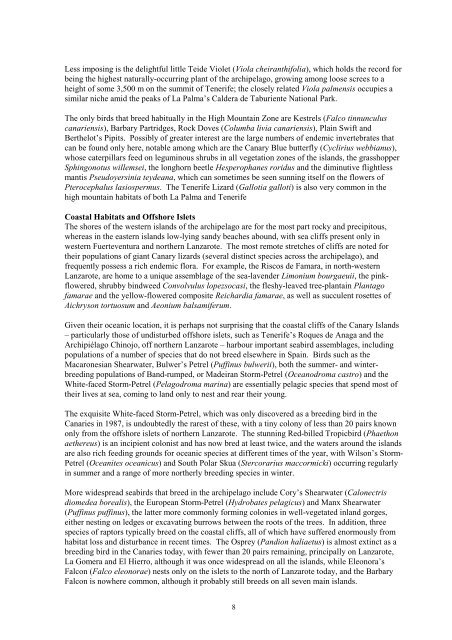Download - Botanical Society of the British Isles
Download - Botanical Society of the British Isles
Download - Botanical Society of the British Isles
- No tags were found...
Create successful ePaper yourself
Turn your PDF publications into a flip-book with our unique Google optimized e-Paper software.
Less imposing is <strong>the</strong> delightful little Teide Violet (Viola cheiranthifolia), which holds <strong>the</strong> record forbeing <strong>the</strong> highest naturally-occurring plant <strong>of</strong> <strong>the</strong> archipelago, growing among loose screes to aheight <strong>of</strong> some 3,500 m on <strong>the</strong> summit <strong>of</strong> Tenerife; <strong>the</strong> closely related Viola palmensis occupies asimilar niche amid <strong>the</strong> peaks <strong>of</strong> La Palma’s Caldera de Taburiente National Park.The only birds that breed habitually in <strong>the</strong> High Mountain Zone are Kestrels (Falco tinnunculuscanariensis), Barbary Partridges, Rock Doves (Columba livia canariensis), Plain Swift andBer<strong>the</strong>lot’s Pipits. Possibly <strong>of</strong> greater interest are <strong>the</strong> large numbers <strong>of</strong> endemic invertebrates thatcan be found only here, notable among which are <strong>the</strong> Canary Blue butterfly (Cyclirius webbianus),whose caterpillars feed on leguminous shrubs in all vegetation zones <strong>of</strong> <strong>the</strong> islands, <strong>the</strong> grasshopperSphingonotus willemsei, <strong>the</strong> longhorn beetle Hesperophanes roridus and <strong>the</strong> diminutive flightlessmantis Pseudoyersinia teydeana, which can sometimes be seen sunning itself on <strong>the</strong> flowers <strong>of</strong>Pterocephalus lasiospermus. The Tenerife Lizard (Gallotia galloti) is also very common in <strong>the</strong>high mountain habitats <strong>of</strong> both La Palma and TenerifeCoastal Habitats and Offshore IsletsThe shores <strong>of</strong> <strong>the</strong> western islands <strong>of</strong> <strong>the</strong> archipelago are for <strong>the</strong> most part rocky and precipitous,whereas in <strong>the</strong> eastern islands low-lying sandy beaches abound, with sea cliffs present only inwestern Fuerteventura and nor<strong>the</strong>rn Lanzarote. The most remote stretches <strong>of</strong> cliffs are noted for<strong>the</strong>ir populations <strong>of</strong> giant Canary lizards (several distinct species across <strong>the</strong> archipelago), andfrequently possess a rich endemic flora. For example, <strong>the</strong> Riscos de Famara, in north-westernLanzarote, are home to a unique assemblage <strong>of</strong> <strong>the</strong> sea-lavender Limonium bourgaeuii, <strong>the</strong> pinkflowered,shrubby bindweed Convolvulus lopezsocasi, <strong>the</strong> fleshy-leaved tree-plantain Plantag<strong>of</strong>amarae and <strong>the</strong> yellow-flowered composite Reichardia famarae, as well as succulent rosettes <strong>of</strong>Aichryson tortuosum and Aeonium balsamiferum.Given <strong>the</strong>ir oceanic location, it is perhaps not surprising that <strong>the</strong> coastal cliffs <strong>of</strong> <strong>the</strong> Canary Islands– particularly those <strong>of</strong> undisturbed <strong>of</strong>fshore islets, such as Tenerife’s Roques de Anaga and <strong>the</strong>Archipiélago Chinojo, <strong>of</strong>f nor<strong>the</strong>rn Lanzarote – harbour important seabird assemblages, includingpopulations <strong>of</strong> a number <strong>of</strong> species that do not breed elsewhere in Spain. Birds such as <strong>the</strong>Macaronesian Shearwater, Bulwer’s Petrel (Puffinus bulwerii), both <strong>the</strong> summer- and winterbreedingpopulations <strong>of</strong> Band-rumped, or Madeiran Storm-Petrel (Oceanodroma castro) and <strong>the</strong>White-faced Storm-Petrel (Pelagodroma marina) are essentially pelagic species that spend most <strong>of</strong><strong>the</strong>ir lives at sea, coming to land only to nest and rear <strong>the</strong>ir young.The exquisite White-faced Storm-Petrel, which was only discovered as a breeding bird in <strong>the</strong>Canaries in 1987, is undoubtedly <strong>the</strong> rarest <strong>of</strong> <strong>the</strong>se, with a tiny colony <strong>of</strong> less than 20 pairs knownonly from <strong>the</strong> <strong>of</strong>fshore islets <strong>of</strong> nor<strong>the</strong>rn Lanzarote. The stunning Red-billed Tropicbird (Phaethonae<strong>the</strong>reus) is an incipient colonist and has now bred at least twice, and <strong>the</strong> waters around <strong>the</strong> islandsare also rich feeding grounds for oceanic species at different times <strong>of</strong> <strong>the</strong> year, with Wilson’s Storm-Petrel (Oceanites oceanicus) and South Polar Skua (Stercorarius maccormicki) occurring regularlyin summer and a range <strong>of</strong> more nor<strong>the</strong>rly breeding species in winter.More widespread seabirds that breed in <strong>the</strong> archipelago include Cory’s Shearwater (Calonectrisdiomedea borealis), <strong>the</strong> European Storm-Petrel (Hydrobates pelagicus) and Manx Shearwater(Puffinus puffinus), <strong>the</strong> latter more commonly forming colonies in well-vegetated inland gorges,ei<strong>the</strong>r nesting on ledges or excavating burrows between <strong>the</strong> roots <strong>of</strong> <strong>the</strong> trees. In addition, threespecies <strong>of</strong> raptors typically breed on <strong>the</strong> coastal cliffs, all <strong>of</strong> which have suffered enormously fromhabitat loss and disturbance in recent times. The Osprey (Pandion haliaetus) is almost extinct as abreeding bird in <strong>the</strong> Canaries today, with fewer than 20 pairs remaining, principally on Lanzarote,La Gomera and El Hierro, although it was once widespread on all <strong>the</strong> islands, while Eleonora’sFalcon (Falco eleonorae) nests only on <strong>the</strong> islets to <strong>the</strong> north <strong>of</strong> Lanzarote today, and <strong>the</strong> BarbaryFalcon is nowhere common, although it probably still breeds on all seven main islands.8
















